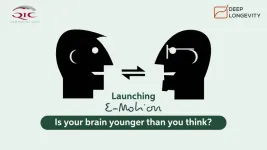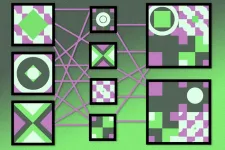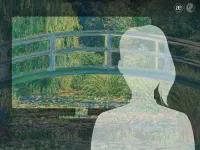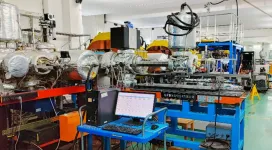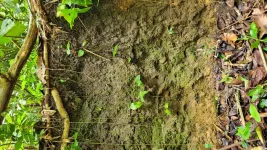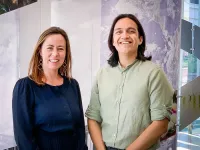(Press-News.org) Scientists' Hubble Space Telescope observations of the young star, TW Hydrae may signal new planets under construction.
In 2017 astronomers reported discovering a shadow sweeping across the face of a vast pancake-shaped gas-and-dust disk surrounding the red dwarf star. The shadow isn't from a planet, but from an inner disk slightly inclined relative to the much larger outer disk – causing it to cast a shadow. One explanation is that an unseen planet's gravity is pulling dust and gas into the planet's inclined orbit.
Now, a second shadow – playing a game of peek-a-boo – has emerged in just a few years between observations stored in the Hubble's MAST archive. This could be from yet another disk nestled inside the system. The two disks are likely evidence of a pair of planets under construction.
George Mason University Physics and Astronomy Professor, Peter Plavchan, collaborated with the team making the observations. He studied ways a forming planet in the disk could potentially play a role in the formation of the disk structures and the shadows they case.
TW Hydrae is less than 10 million years old and resides about 200 light-years away. In its infancy, our solar system may have resembled the TW Hydrae system, some 4.6 billion years ago. Because the TW Hydrae system is tilted nearly face-on to our view from Earth, it is an optimum target for getting a bull's-eye-view of a planetary construction yard.
The second shadow was discovered in observations obtained June 6, 2021, as part of a multi-year program designed to track the shadows in circumstellar disks. John Debes of AURA/STScI for the European Space Agency at the Space Telescope Science Institute in Baltimore, Maryland, compared the TW Hydrae disk to Hubble observations made several years ago.
"We found out that the shadow had done something completely different," said Debes, who is principal investigator and lead author of the study published in The Astrophysical Journal. "When I first looked at the data, I thought something had gone wrong with the observation because it wasn't what I was expecting. I was flummoxed at first, and all my collaborators were like: what is going on? We really had to scratch our heads and it took us a while to actually figure out an explanation." Debes shared.
“We haven't found any direct evidence for a planet at this time, but can rule out planets more massive than Jupiter from precisely monitoring the position of the star as a function of time,” said Plavchan, who also serves as Director of the Mason Observatory.
The best solution the team identified is that there are two misaligned disks casting shadows. They were so close to each other in the earlier observation, they were missed. Over time, they've now separated and split into two shadows. "We've never really seen this before on a protoplanetary disk. It makes the system much more complex than we originally thought," Debes said.
The simplest explanation is that the misaligned disks are likely caused by the gravitational pull of two planets in slightly different orbital planes. Hubble is piecing together a holistic view of the architecture of the system.
The disks may be proxies for planets that are lapping each other as they whirl around the star. It's sort of like spinning two vinyl phonograph records at slightly different speeds. Sometimes labels will match up but then one gets ahead of the other.
"It does suggest that the two planets have to be fairly close to each other. If one was moving much faster than the other, this would have been noticed in earlier observations. It's like two race cars that are close to each other, but one slowly overtakes and laps the other," said Debes.
The suspected planets are located in a region roughly the distance of Jupiter from our Sun. And, the shadows complete one rotation around the star about every 15 years – the orbital period that would be expected at that distance from the star.
Also, these two inner disks are inclined about five to seven degrees relative to the plane of the outer disk. This is comparable to the range of orbital inclinations inside our solar system. "This is right in line with typical solar system style architecture," said Debes.
The outer disk that the shadows are falling on may extend as far as several times the radius of our solar system's Kuiper belt. This larger disk has a curious gap at twice Pluto's average distance from the Sun. This might be evidence for a third planet in the system.
Any inner planets would be difficult to detect because their light would be lost in the glare of the star. Also, dust in the system would dim their reflected light. ESA's Gaia space observatory may be able to measure a wobble in the star if Jupiter-mass planets are tugging on it, but this would take years given the long orbital periods.
The TW Hydrae data are from Hubble's Space Telescope Imaging Spectrograph. The James Webb Space Telescope's infrared vision may also be able to show the shadows in more detail.
The Hubble Space Telescope is a project of international cooperation between NASA and ESA. NASA's Goddard Space Flight Center in Greenbelt, Maryland, manages the telescope. The Space Telescope Science Institute (STScI) in Baltimore conducts Hubble science operations. STScI is operated for NASA by the Association of Universities for Research in Astronomy, in Washington, D.C.
END
Playing shadow puppets with NASA's Hubble Space Telescope
2023-05-05
ELSE PRESS RELEASES FROM THIS DATE:
Aston Medical School given full approval by the General Medical Council
2023-05-05
Aston Medical School has been given full approval by the General Medical Council (GMC), meaning they can award degrees to graduating students for the first time this year.
The Medical School at Aston University completed the GMC’s rigorous quality assurance process, which began in 2016. The decision, ratified by the GMC’s Council, means Aston Medical School can be added to the list of UK bodies able to award a primary medical qualification.
The approval means that from this summer, medical graduates from Aston University will be added to the medical register and will be able to join the UK’s healthcare workforce ...
QIC reshaping mental health landscape with Deep Longevity aging clocks
2023-05-05
QIC-DVP, an entity of Qatar Insurance Group, the leading insurance provider in the Qatar and MENA region, has launched E-Motion with Deep Longevity. It will enable the populace to measure their customers' psychological age, improve mental health, and increase longevity from the comfort of their home.
The assessment-based and AI-powered digital application has been developed with Deep Longevity's Psychological Age . The technology aims to reinforce mental resilience and wellbeing.
Psychological age, calculated using a proprietary ...
Researchers create a tool for accurately simulating complex systems
2023-05-05
Researchers often use simulations when designing new algorithms, since testing ideas in the real world can be both costly and risky. But since it’s impossible to capture every detail of a complex system in a simulation, they typically collect a small amount of real data that they replay while simulating the components they want to study.
Known as trace-driven simulation (the small pieces of real data are called traces), this method sometimes results in biased outcomes. This means researchers might unknowingly choose an algorithm that is not the best one they evaluated, and which will perform worse on real data than the simulation predicted that it should.
MIT researchers ...
How online art viewing can impact our well-being
2023-05-05
Art can have a positive effect on our mood. But does this also work when we look at paintings on a screen? An international research team involving the University of Vienna, the Max Planck Institute for Psycholinguistics in Nijmegen and the Max Planck Institute for Empirical Aesthetics (MPIEA) in Frankfurt am Main decided to investigate this question. The study was funded by the EU Horizon ART*IS Project. The results have now been published as an open access article in the journal Computers in Human Behavior.
240 study participants viewed an interactive Monet Water ...
Precision mass measurements of nuclei reveal neutron star properties
2023-05-05
Researchers at the Institute of Modern Physics (IMP) of the Chinese Academy of Sciences (CAS) and their collaborators recently measured the masses of several key nuclei with high-precision by employing a state-of-the-art storage-ring mass spectrometry technique. Using the new mass data, they investigated X-ray bursts on the surface of a neutron star, thus deepening the understanding of neutron star properties. The study was published in Nature Physics.
Neutron stars are considered to be the densest objects besides black holes. Type-I X-ray bursts, among the brightest stellar ...
Terasaki Institute holds grand opening celebration at new research center
2023-05-05
(WOODLAND HILLS, CA) – The Terasaki Institute for Biomedical Innovation (TIBI), a non-profit research organization devoted to developing bioengineered systems, devices, and technology for biomedical applications, held a Grand Opening celebration at their newest research facility in Woodland Hills. The event drew almost 100 guests, which included local dignitaries, members of the Terasaki family, TIBI faculty and staff, and members of the building’s design and construction teams.
A special Grand Opening program, emceed by KTLA 5 Morning News anchor Frank Buckley, began with certificates of commendation presented ...
Tuning brain cells with light
2023-05-05
An international research team, comprising scientists from DZNE, University Hospital Bonn, the Netherlands, and the US has been awarded a US$ 1.3 million grant by the “Human Frontier Science Program” to investigate brain immune cells and manipulate them via light irradiation. This will involve using gene transcripts (mRNAs) as molecular mediators. From these laboratory studies, the scientists aim to gain new insights into how these cells change their shape in response to hazards and the role they play in neurodegenerative ...
Secret behind Amazonian 'dark earth' could help speed up forest restoration across the globe
2023-05-05
Between approximately 450 BCE and 950 CE, millions of Amerindian people living in today’s Amazonia transformed the originally poor soil through various processes. Over many human generations, soils were enriched with charcoal from their low-intensity fires for cooking and burning refuse, animal bones, broken pottery, compost, and manure. The result is Amazonian dark earth (ADE) or terra preta, exceptionally fertile because rich in nutrients and stable organic matter derived from charcoal, which gives it its black color.
Now, scientists from Brazil show that ADE could be a ‘secret weapon’ to boost reforestation – not only in the Amazon, where 18% or ...
Altruism can make job seekers afraid to negotiate salary
2023-05-05
AUSTIN, Texas — Job seekers looking to land a role with an altruistic organization may feel too guilty to ask for higher pay, according to a new study from the McCombs School of Business at The University of Texas at Austin.
Both for-profit and nonprofit organizations increasingly employ what has been termed “social impact framing” that emphasizes that their work has welfare benefits for society.
Although companies might have entirely noble intentions when using social impact framing, a recent study by Texas McCombs Assistant Professor of Management ...
How diet quality affects the gut microbiota to promote health
2023-05-05
URBANA, Ill. – We know that eating a healthy diet affects body weight, cholesterol levels, and heart health. A new study from the University of Illinois focuses on another component: the role of diet in supporting a healthy gastrointestinal microbiota. The researchers conclude that following the Dietary Guidelines for Americans (DGA) promotes a gut microbiota composition that may support overall health.
“Currently, there is no definition of a ‘healthy’ microbiome. Understanding how diet may influence the structure of the gut microbiota is important so we can make recommendations on dietary approaches,” says ...

